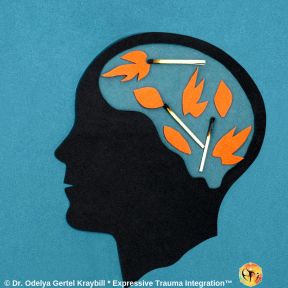Pediatric autoimmune neuropsychiatric disorders associated with streptococcal infections—PANDAS for short—is a childhood syndrome thought to be triggered by strep throat and related infections from strep bacteria. Children with PANDAS syndrome will typically develop tics—uncontrolled movements or sounds—and/or symptoms of obsessive-compulsive disorder, seemingly overnight. Other symptoms may arise as well; children diagnosed with PANDAS can display dramatic mood swings or experience sudden bouts of anxiety, and some evidence suggests that a small number may display signs of anorexia.
Though undoubtedly alarming to many parents—especially due to their rapid onset—these symptoms are thought to be the result of an immune reaction and usually improve once the infection has been treated.
Contents

PANDAS is a complex—and to many, controversial—syndrome. First recognized by neuropsychiatrist Susan Swedo in a 1998 paper, PANDAS is thought to be related to Sydenham's chorea, or "St. Vitus' dance," an autoimmune disorder triggered by streptococcus bacteria that results in rapid, jerking movements in affected children. While studying Sydenham's, Swedo identified a group of children who appeared to develop other more complex symptoms, like those of OCD, after contracting strep. After examining and treating many of the children by targeting their strep infections, Swedo theorized that PANDAS may be the cause.
Many children have since been diagnosed with and treated for PANDAS, and many families believe that the syndrome was the cause of their child's symptoms. But Swedo's original study—and many studies that have looked at PANDAS since then—included only a small number of children, and have been criticized by some experts for creating an illusion of causality. Though the National Institutes of Mental Health (where Swedo currently serves as Chief of the Pediatrics and Developmental Neuroscience Branch) formally recognizes PANDAS, others in the field caution that more research is needed to better understand why such symptoms might develop.
Some estimates suggest that PANDAS may affect as many as 1 in 200 children in the U.S. However, some researchers and clinicians dispute that number, and argue that the condition is overdiagnosed—especially because many of the symptoms can have other potential causes besides strep bacteria.
Children are thought to be at the greatest risk of PANDAS between the ages of 3 and 12. Children older than 12 have developed symptoms only in very rare cases.
PANDAS is, by definition, a pediatric diagnosis. Whether adults can also develop OCD or tic disorders in response to strep infections is not fully understood, as little research has been done in this area and strep throat is significantly less common in adults. However, there have been documented cases in which adult psychiatric symptoms—such as psychosis—appeared to be triggered by infections or by the body’s immune response, suggesting that adult-onset neuropsychiatric strep reactions may, in theory, be possible.
A small amount of evidence suggests that PANDAS symptoms may show a gender disparity, with boys being more likely to develop tics and girls more likely to develop OCD-like behaviors.
PANDAS is considered to be a subset of pediatric acute-onset neuropsychiatric syndrome, or PANS. Children who develop sudden, dramatic symptoms of OCD or eating disorders—seemingly overnight—may be given a diagnosis of PANS if all other possible causes are ruled out. PANS is like PANDAS in that the most likely cause is thought to be an abnormal immune reaction; unlike PANDAS, it is not related to strep bacteria. Other possible causes of PANS include metabolic disturbances or inflammation-related issues.
PANDAS is not formally listed in the DSM-5. However, the syndrome is mentioned under "Obsessive-Compulsive and Related Disorder Due to Another Medical Condition," with the acknowledgment that it is a disputed condition: "Although there is a body of evidence that supports the existence of PANDAS, it remains a controversial diagnosis." The DSM authors note that PANDAS, PANS, and CANS (a broader term that stands for childhood acute neuropsychiatric symptoms and is intended to remove strep and other infections from the diagnosis) are conditions that warrant further study.

The exact cause of PANDAS is not yet fully understood, but researchers posit that a hyperactive immune response to streptococcus bacteria may be to blame. Streptococcus bacteria are responsible for strep throat infections, a common ailment among children.
Most children will not develop psychiatric symptoms as a result of strep. But because strep bacteria disguise themselves as human cells, in a small number of children, some antibodies that form in response to a strep infection may fail to attack the strep itself. Instead, experts theorize that they mistakenly target the brain, most notably a part known as the basal ganglia that is implicated in motor movement, habit learning, and emotion. Studies from the National Institute of Mental Health, among others, suggest that this misfired antibody response interferes with basal ganglia function, triggering symptoms of OCD, tic disorders, or anxiety. When the infection has been successfully treated, the antibodies will retreat and symptoms will typically wane.
Some experts dispute the PANDAS hypothesis, arguing that the diagnostic criteria are too loose and the causal connection has not been clearly established. Instead, some suggest that many children with PANDAS could simply have previously undiagnosed OCD, tics, or other psychiatric ailments, and that overdiagnosis of PANDAS could result in excessive antibiotic use, which may have negative long-term effects on children’s health.
Almost all school-aged children will be exposed to strep bacteria, and the vast majority who develop strep throat will make a full recovery without displaying any psychiatric symptoms. PANDAS syndrome is characterized by its rapid onset, though, so concerned parents should know quickly after a strep infection is diagnosed whether their child is displaying potential PANDAS symptoms.

According to the NIMH, PANDAS can be diagnosed in pre-pubertal children (between the ages of 3 and 12, generally) if the following symptom criteria are met:
- The presence of OCD symptoms (repetitive thoughts, obsessive fears, and/or compulsive behaviors), tics, or both.
- A positive strep culture or a history of scarlet fever; if more than a week has passed since the onset of symptoms, a blood test may be required to determine the presence of strep.
- A very abrupt onset or worsening of symptoms that is associated with the onset of strep.
Whether or not a child has been exposed to strep bacteria can be determined via lab testing. However, the presence of strep is not enough to warrant a PANDAS diagnosis, and there is no definitive test to determine whether or not a child has PANDAS. If a child displays sudden, dramatic symptoms of OCD or tics, in addition to a positive strep test, a doctor may make a PANDAS diagnosis; they may, however, withhold a diagnosis as they search for other potential causes of the symptoms.
OCD symptoms and tics are the most prominent symptoms of PANDAS. However, many children with the syndrome also develop intense anxiety—sometimes reaching the point of panic attacks—or dramatic mood swings; tantrums or meltdowns are sometimes reported in PANDAS patients. Children may also demonstrate changes in fine motor skills (struggling with handwriting, for instance), as well as sleep problems; some children, even older ones, may start to wet the bed or begin to urinate more frequently during the day. Some children—mostly girls, according to some small studies—may also start restricting food or show other symptoms of anorexia.
PANDAS is marked by its extremely sudden onset—some parents report that their child seemingly became a totally different person overnight. To differentiate between PANDAS and OCD or tic disorders, then, doctors typically examine the trajectory of the symptoms. If they appear suddenly, rather than developing over time, coincide with the presence of strep bacteria, and improve slowly as the infection clears, the doctor may determine that they are indicative of PANDAS.
Not necessarily. Children with OCD and tic disorders can and do get strep throat—in most cases, the conditions are entirely unrelated. If the child only developed OCD symptoms or tics very suddenly after contracting strep throat—or if the symptoms went away once the strep was treated—it’s possible that they were due to PANDAS.
Tic disorders usually onset in early childhood, so a child developing a tic is not in itself a sign of PANDAS. Tics wax and wane—and can be suppressed with effort—meaning that in some cases, a tic may seem to “suddenly” appear. In rare cases, tic disorders may be the result of a strep infection. However, Susan Swedo, the researcher who is credited with discovering PANDAS, cautions that a PANDAS diagnosis should only be granted when all other possible explanations for tics (and other PANDAS symptoms) have been ruled out.

To treat PANDAS, the NIMH emphasizes, the underlying strep infection must be treated. In many cases, this can be accomplished with a single course of antibiotics. More serious strep infections may require a longer course of treatment or multiple courses of antibiotics. Once the strep has been treated, PANDAS symptoms will typically start to fade, the NIMH reports, though they may take a few months to disappear altogether.
To prevent strep reinfection, parents should discard toothbrushes and sterilize other objects that go into a child’s mouth. Testing siblings for strep may also be a good idea, even if they’re not showing symptoms; they may be carrying the bacteria and could potentially reinfect the affected child.
Though the symptoms of PANDAS should subside once the infection has been treated, progress may be slow, and a short course of therapy can help a child manage the conditions in the meantime. Cognitive-behavioral therapy (CBT) or exposure and response prevention therapy (ERP) can help a child take control of obsessions or compulsions or learn coping skills to handle strong emotions while the treatment takes its course.
Some children with PANDAS may respond positively to SSRIs. However, the NIMH cautions that children with PANDAS may be more likely than other children to experience significant side effects from these drugs, so it’s best to start with a low dose and stop use (under a doctor’s supervision) if symptoms start to worsen or side effects become unmanageable.
PANDAS symptoms usually fade once the underlying infection is treated. Untreated, PANDAS may continue to worsen and could turn into a chronic condition. But because untreated strep throat can cause complications above and beyond PANDAS, a course of antibiotics is usually recommended, regardless of psychiatric symptoms. PANDAS symptoms may return if a child gets strep throat again, in which case antibiotic treatment may need to be restarted.















